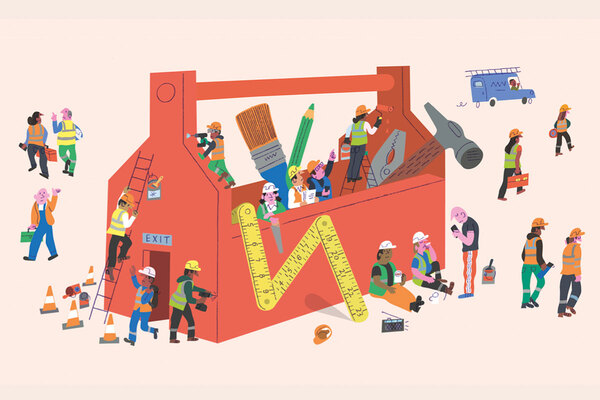How social landlords can tackle labour shortages in construction and repairs
The number of skilled people working in construction and repairs is falling, and many are leaving for better pay in the private sector. How can social landlords respond? Neil Butters sets out some strategies that can make jobs in the sector more attractive
Chronic labour shortages are fast overtaking materials availability as the number-one risk for social landlords around asset management and development.
Housing providers are being forced to stall planned maintenance programmes because they can’t procure enough electricians and joiners or pay them the rates they’re demanding.
“Vacancies are nearly double what they were before the pandemic – 48,000 compared to 27,000 – despite construction output returning to pre-COVID levels”
I’ve heard of some local authorities and housing associations searching for PAS 2035 retrofit co-ordinators and qualified fire risk assessors but finding none because demand is so high. As a result, they’re missing out on net zero funding and struggling with building safety targets.
Despite furlough ending last year, the number of skilled tradespeople returning to work in construction hasn’t had the boost many hoped for. Vacancies are nearly double what they were before the pandemic – 48,000 compared to 27,000 – despite construction output returning to pre-COVID levels.
The post-pandemic ‘great resignation’ is making things worse, with many tradespeople reassessing how and where they work. Another factor is the ageing construction workforce. Large numbers of UK-born workers – the generation who started on sites in the 1980s – are retiring this decade.
“Alarmingly, there are 96,000 gas engineers in the UK, but only 1,000 heat-pump installers”
With Brexit done, construction can no longer rely on insourced European labour to fill the gaps. The whole situation is intensified by ever-increasing demand to procure fire safety and net zero works, and new builds.
The lack of any co-ordinated UK construction training strategy is also an issue. The government’s Lifetime Skills Guarantee is too little, too late, especially in combination with the absence of any large-scale retrofit skills programme. Alarmingly, there are 96,000 gas engineers in the UK, but only 1,000 heat-pump installers.
But it isn’t just a shortage of eco-specialists. A wide range of construction companies and supporting industries are also feeling the pinch. For instance, many builders’ merchants are suffering due to the ongoing shortage of HGV drivers, and Brexit has affected the number of candidates available for low-paid manufacturing jobs.
“One way to fill the skills gap is by looking for more women and people from diverse communities, showing them that this is a valuable and exciting career choice”
The social housing sector will soon reach crisis point on labour shortages and wage costs. It must act now. Providers can take things into their own hands. Here are some suggestions how:
- Make jobs in the sector more attractive
Working as a social housing gas engineer might not top the career wish list for lots of young people, but becoming a renewable technology specialist might be a different story. Retrofit is a cutting-edge industry, with new kit constantly being released, keeping things interesting for digital-native job hunters.
Another issue is diversity. Traditionally, asset management and development has had an ageing, male-dominated workforce. One way to fill the skills gap is by looking for more women and people from diverse communities, showing them that this is a valuable and exciting career choice. - Rethink wages
If housing organisations refuse every labour-price increase, tradespeople will leave for better-paid work. In many cases, this means dropping social housing jobs for private sector projects, where rates are higher. Think hard about wage-rise requests and be realistic about what’s acceptable and what’s not in the current climate. - Develop college partnerships
Build up the skills of local workers by joining forces with local colleges, universities, construction firms and other housing providers to develop training academies, apprenticeship programmes and graduate schemes focusing on subjects such as external wall insulation, fire risk surveying and modern methods of construction. This is about capturing the imagination of young people coming into the workplace, but also demonstrating the opportunities to established workers looking for a career change. - Normalise retrofit
Many tradespeople still see eco-improvements as a mysterious, elite world that requires multiple university degrees to join. Landlords need to mainstream retrofit as a career choice, making it accessible and showing the wide-ranging benefits. - Maintain, retrain and retain
Despite the transition to heat pumps, housing organisations still need their workforce to maintain existing gas boilers. It’s not as simple as immediately retraining all operatives in heat-pump repair and installation or only hiring renewable-energy engineers. Social landlords must take a carefully planned, twin-track approach to recruitment and training over the coming years.
Holding on to your workforce is also key – particularly when you need highly skilled roles for rural areas. Think about how you can incentivise specialists to stay and serve less-central, more-isolated regions. This might be about investing in training, rethinking wages, offering flexible working or making more of the environmental and societal benefits of working in social housing – which is particularly attractive to people looking for something different from their job and life after COVID.
With this imbalance between the supply and demand of skilled labour set to continue for the next 12 months, housing providers must develop effective coping strategies now. Don’t wait for high-level policy on construction training to change – pull together and be part of the solution on skills.











